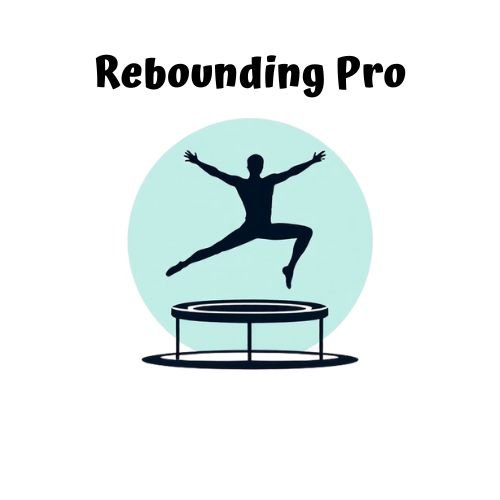High-intensity jumping on a rebounder burns massive calories because it creates a 68% VO₂ max cardiovascular response while engaging multiple muscle fibers through vertical G-forces. You’ll burn 6.9-12.4 calories per minute while experiencing less joint stress than running. The afterburn effect keeps your metabolism elevated for up to 24 hours post-workout, maximizing fat burning. Discover how this NASA-validated exercise method transforms your body into a calorie-burning powerhouse with just minutes per day.
The Science Behind Rebounder Metabolic Expenditure

While traditional cardio exercises dominate fitness conversations, rebounding’s unique metabolic impact deserves closer examination.
When you bounce, you’re activating your cardiovascular system at 68% VO₂ max with considerably lower oxygen consumption than treadmill workouts.
The secret lies in vertical G-forces that engage multiple muscle fibers simultaneously. Your body recruits stabilizing core and postural muscles throughout each bounce, creating a full-body workout that traditional cardio can’t match. NASA research confirms that rebounding provides less metabolic cost while delivering equivalent cardiovascular benefits.
At 7.0 METs during vigorous sessions, you’re burning calories equivalent to running at 8.8 mph—but with dramatically reduced joint impact.
Experience the efficiency of rebounding: high-intensity calorie burn equivalent to fast running without punishing your joints.
Your body’s response to elastic surface training amplifies EPOC (excess post-exercise oxygen consumption), meaning you’ll continue burning calories hours after your workout ends.
How Rebounding Amplifies Your Body’s Calorie-Burning Potential
When you step onto a rebounder for a high-intensity session, your body transforms into a calorie-burning powerhouse unlike any traditional exercise. Your heart rate quickly elevates, optimizing your caloric expenditure both during and after your workout.
What makes rebounding particularly effective is its unique biomechanical load. Each bounce recruits multiple muscle groups simultaneously while your core stays constantly engaged for balance. This thorough muscle activation generates significant heat and energy demand, burning between 6.9-12.4 calories per minute. With consistent practice, you could burn approximately 820 calories in just 10 days.
Your body weight works with—not against—you during rebounding. The intensity triggers adrenaline release and metabolic adaptations that support the afterburn effect, keeping your metabolism elevated for hours afterward.
This hormonal response optimizes glucose metabolism and fat utilization, making every minute on the rebounder count toward your fitness goals.
Comparing Rebounding to Traditional Cardio: Caloric Impact

Your rebounding workouts contribute to higher mitochondrial density in muscle cells, supercharging your body’s calorie-burning machinery more effectively than traditional cardio.
This cellular adaptation means you’ll burn more calories during exercise and throughout your day, even when resting.
Studies show rebounding is 68% more effective than running for calorie burn, while simultaneously putting less stress on your joints.
The afterburn effect from high-intensity rebounding sessions extends your calorie expenditure for hours after you’ve finished jumping, a metabolic advantage that standard cardio often doesn’t match.
Mitochondrial Density Matters
Although often overlooked in fitness discussions, mitochondrial density plays an essential role in determining how efficiently your body burns calories during exercise. Your body’s cellular powerhouses adapt differently depending on the type of workout you choose.
Traditional cardio like running or cycling delivers consistent results for increasing mitochondrial density, thanks to sustained aerobic demands that trigger significant biogenesis.
Meanwhile, rebounding offers unique benefits through its combined resistance and aerobic elements. Training frequency and intensity are critical factors for optimizing mitochondrial adaptations during any exercise program.
Consider these key differences:
- Traditional cardio creates more robust increases in mitochondrial volume and respiratory enzymes.
- HIIT and rebounding promote mitochondrial fusion and network connectivity, improving efficiency.
- All exercise types enhance electron transport chain activity, but endurance training produces the most pronounced effects on mitochondrial size.
Afterburn Effect Amplified
Beyond building cellular powerhouses, high-intensity rebounding workouts trigger a metabolic phenomenon that continues long after you’ve stepped off the mini-trampoline.
This “afterburn effect” (EPOC) keeps your metabolism elevated for up to 24 hours post-exercise.
Unlike traditional steady-state cardio, rebounding’s high-impact nature creates a greater oxygen debt your body must repay during recovery. Comparable to plyometric exercises, rebounding engages explosive movements that significantly increase your body’s demand for oxygen during recovery.
As your system works to clear lactic acid, replenish oxygen stores, and repair muscle fibers, you’re burning additional calories without lifting a finger.
The multi-muscle engagement during rebounding amplifies this effect compared to conventional cardio options.
By working at higher intensities (around 80% VO2 max), you’ll maximize EPOC and your caloric expenditure.
This metabolic boost, combined with rebounding’s varied movements, delivers superior fat-burning results compared to traditional cardio approaches.
HIIT Rebounding: Maximizing Calorie Burn in Minimal Time
When time constraints limit your workout options, HIIT rebounding emerges as a remarkably efficient calorie-burning solution. In just 12 minutes, you’ll burn the equivalent calories of running a mile—but with considerably less joint impact and perceived exertion.
The time-efficiency of rebounding HIIT is unmatched, delivering impressive results through:
- Metabolic acceleration – Short, intense bursts elevate your heart rate quickly and maintain elevated metabolism post-workout
- Customizable intensity – Adjust from gentle bouncing to powerful plyometric movements based on your fitness level
- Sustainable effort – Low-impact nature allows you to perform high-intensity intervals safely, supporting consistency
At approximately 6.9-12.4 calories burned per minute, even brief daily sessions create meaningful caloric deficits without overwhelming your schedule. This low-impact exercise is especially beneficial for those with joint concerns as it provides cushioned landing that reduces stress while still delivering significant fitness benefits.
The Full-Body Engagement Effect on Energy Consumption

Unlike isolated exercises that target specific muscle groups, rebounding activates your entire musculature simultaneously, dramatically increasing energy expenditure during each session.
When you’re bouncing, your body engages core stabilizers, leg muscles, and upper body components in a synchronized effort to maintain balance and execute movements.
This full-body recruitment triggers a higher caloric burn than exercises that isolate single muscle groups. Your body expends energy not just for the jumping action itself, but also for the constant stabilization required during each landing and takeoff.
The varied intensity levels during rebounding sessions further enhance this effect, as your muscles continuously adapt to changing forces. These short bursts of intense jumping followed by recovery periods make rebounding an effective HIIT workout that maximizes calorie burning in minimal time.
The result is a metabolic boost that continues even after your workout ends, maximizing calorie consumption through extensive muscular engagement rather than segmented activity.
Measuring and Tracking Your Rebounder Workout Results
Three essential methods can help you accurately measure the caloric impact of your rebounding workouts. Understanding your energy expenditure allows you to optimize results and track progress over time.
For precise tracking, consider these approaches:
- Heart rate monitoring – Wear a fitness tracker during sessions to correlate your heart rate with caloric burn, providing personalized data rather than generic estimates.
- MET value calculations – Apply the formula: Calories burned = ((7.2 × 3.5 × your weight in kg) ÷ 200) × minutes jumped. This scientific approach accounts for your specific body weight.
- Duration recording – Track your session length (10-30+ minutes) consistently, as longer workouts proportionally increase total calories burned. Studies show rebounding can burn between 6.9 and 12.4 calories per minute depending on intensity and body weight.
Aim to gradually extend your stamina while maintaining intensity.
Frequently Asked Questions
Is Jumping Rope Safe for People With Joint Issues?
Jumping rope can be safe if you’re careful. Use proper technique, wear supportive shoes, choose soft surfaces, and progress gradually. If you have existing joint problems, consult your doctor before starting this high-impact exercise.
Can Jumping Exercises Help Reduce Localized Body Fat?
While jumping exercises primarily burn calories overall, you’ll see more targeted fat loss with consistent workouts. They engage specific muscle groups, potentially aiding localized fat reduction when combined with a caloric deficit and balanced diet.
How Does Altitude Affect Calorie Burning During Jumping Workouts?
At higher altitudes, you’ll burn more calories during jumping workouts as your body works harder with less oxygen. Your muscles demand extra energy, and your metabolic rate increases to compensate for the thinner air.
Are Weighted Jump Ropes Worth the Extra Investment?
Yes, weighted jump ropes are worth your investment. They’ll double your calorie burn, engage more muscles, and improve coordination faster than standard ropes. You’ll get better full-body workouts in less time with increased resistance.
Does Jumping on Different Surfaces Impact Calorie Burn Rates?
Yes, surface matters! You’ll burn more calories on hard surfaces that demand shock absorption and unstable surfaces requiring balance. Soft, high-rebound surfaces slightly reduce caloric expenditure by decreasing muscular workload and enhancing energy return.
In Summary
As you’ve discovered, rebounding isn’t just fun—it’s a calorie-burning powerhouse. Your body works overtime during high-intensity jumps, activating more muscle groups than traditional cardio while putting less strain on your joints. By incorporating HIIT techniques on your rebounder, you’re maximizing metabolic impact in minimal time. Track your results and you’ll see why this bouncing exercise has become a go-to for efficient, effective calorie burning.





Leave a Reply